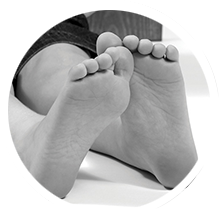What Is Hammertoe?
Hammertoe is a contracture (bending) of one or both joints of the second, third, fourth, or fifth (little) toes. This abnormal bending can put pressure on the toe when wearing shoes, causing problems to develop.
Hammertoes usually start out as mild deformities and get progressively worse over time. In the earlier stages, hammertoes are flexible and the symptoms can often be managed with noninvasive measures. But if left untreated, hammertoes can become more rigid and will not respond to non-surgical treatment.
Because of the progressive nature of hammertoes, they should receive early attention. Hammertoes never get better without some kind of intervention. If you suspect you suffer from a Hammertoe we can help. Call us or click here to arrange an appointment. (Insert link to make an appointment)
Causes
The most common cause of hammertoe is a muscle/tendon imbalance. This imbalance, which leads to a bending of the toe, results from mechanical (structural) changes in the foot that occurs over time in some people.
Hammertoes may be aggravated by shoes that don’t fit properly. A hammertoe may result if a toe is too long and is forced into a cramped position when a tight shoe is worn. We can advise you on the correct footwear for a Hammertoe and we also have a range of shoes in stock that may suit this condition.
Occasionally, hammertoe is the result of an earlier trauma to the toe. In some people, hammertoes are inherited.
Symptoms
Common symptoms of hammertoes include:
- Pain or irritation of the affected toe when wearing shoes.
- Corns and calluses (a buildup of skin) on the toe, between two toes, or on the ball of the foot. Corns are caused by constant friction against the shoe. They may be soft or hard, depending upon their location.
- Inflammation, redness, or a burning sensation
- Contracture of the toe
- In more severe cases of hammertoe, open sores may form.
Diagnosis
At Dalkey Podiatry Clinic we will examine your feet and may attempt to reproduce your symptoms by manipulating your foot to study the contractures of the toes.
Hammertoes are progressive – they don’t go away by themselves and usually they will get worse over time. However, not all cases are alike – some hammertoes progress more rapidly than others. Once we have evaluated your hammertoes, a treatment plan can be developed that is suited to your needs.
Non-surgical Treatment
There are a variety of treatment options for hammertoe. The treatment we advise will depend upon the severity of your hammertoe and other factors.
A number of non-surgical measures can be undertaken:
- Padding corns and calluses. We can provide pads designed to shield corns from irritation. It is advisable not to try over the counter pads as some of the medicated pads sold in pharmacies may contain a small amount of acid that can be harmful.
- Changes in shoewear. Avoid shoes with pointed toes, shoes that are too short, or shoes with high heels – conditions that can force your toe against the front of the shoe. Instead, choose comfortable shoes with a deep, roomy front and heels no higher than two inches.
- Orthotic devices. We can prepare a custom orthotic device which when placed in your shoe may help control the muscle/tendon imbalance.
- Injection therapy. We can refer you for Corticosteroid injections which are sometimes used to ease pain and inflammation caused by hammertoe.
- Medications. Oral nonsteroidal anti-inflammatory drugs (NSAIDs), such as ibuprofen, may be recommended to reduce pain and inflammation.
- Splinting/strapping. Splints or small straps may be applied by our podiatrists to realign the bent toe.
When Is Surgery Needed?
In some cases, usually when the hammertoe has become more rigid and painful, or when an open sore has developed, surgery is needed.
Often patients with hammertoe have bunions or other foot deformities corrected at the same time. During your consultation at the clinic we will assist you in selecting the procedure or combination of procedures for your particular case taking into consideration the extent of your deformity, the number of toes involved, your age, your activity level, and other factors. The length of the recovery period will vary, depending on the procedure or procedures performed.


Error: Contact form not found.



